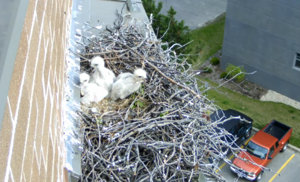HawkCam attracts thousands of viewers
There’s only one thing growing faster than the three feathery lumps in the hawk’s nest on Weeks Hall: their audience.
A pair of red-tailed hawks is raising three young chicks — formally called eyasses — on a ledge just below the four-story roof edge on the Geosciences building and under the watchful eye of a live webcam.

Three hawk chicks are shown in the nest at Weeks Hall.
“The people here in the center are having a good time watching,” says John Lalande, a Linux systems administrator at the Space Science and Engineering Center in the AOSS Building next door to Weeks. “But it’s really been nice to share with people outside the center.”
SSEC operates a handful of cameras on the AOSS roof, monitoring cloud formations and occasionally catching a streaking meteor.
“We decided to repurpose one of our cameras for a few months so we could see what’s going on with the hawks,” Lalande says.
Tens of thousands have tuned in, often nearly 1,000 at a time at http://metobs.ssec.wisc.edu/aoss/cameras/hawkcam-flash.html. The camera has hosted more than 70,000 viewers since Lalande and others moved the live streaming video a week ago to a pair of commercial services that could handle the increased traffic following attention from the Associated Press and local media outlets.
The hawks have nested at Weeks for at least three years, and been an Internet attraction for two. In March, Lalande worked with instrument specialists Nick Ciganovich of SSEC and Brian Hess of the Department of Geosciences to upgrade the camera.
“Nick actually slung the thing over the edge and got it set up,” Lalande says, “while I got to stand around and watch for dive-bombing hawks.”
With the camera just 10 feet from the nest, viewers have a high definition view of the nest’s residents — which started out as a pair of young adults and three eggs.
The eggs hatched on April 19, and the chicks’ steady growth has meant more time off-camera for their parents.
“We’ve had people writing us emails saying, ‘I haven’t seen the parents for a while. Are they gone? Maybe the chicks should be in an incubator instead of an empty nest,’” Lalande says.
Mark Berres, UW–Madison ornithologist, has tried to set concerns aside.
“An increase in off-nest parental activity is not unusual,” says Berres, who assures viewers there’s also no unusual danger. “Since they are growing rapidly, the parents must provide more food to meet their dietary needs. Three chicks means a lot of hunting is required to meet these demands.”
Those needs will only grow with the eyasses as they get closer to venturing out of the nest. Red-tails often take wing first around six weeks. Chances are that moment will be eagerly anticipated by thousands of fans — including two watchful parents.
“If you’re in this neck of the woods around campus, you see them out and about. We see them now and then on our other cameras,” Lalande says. “They don’t get too far away.”
